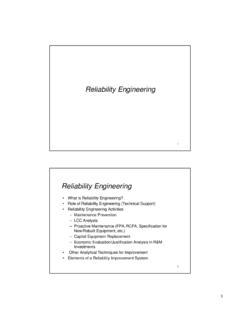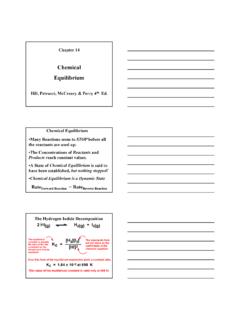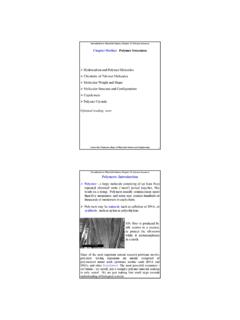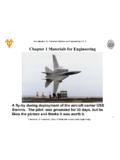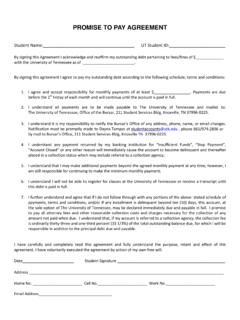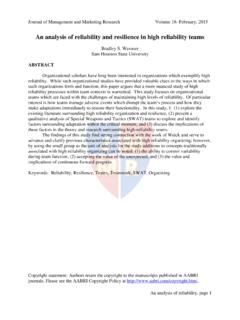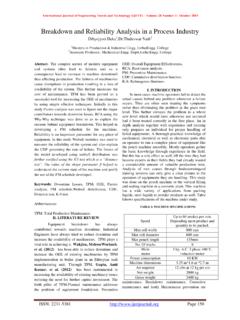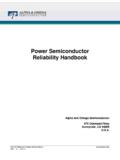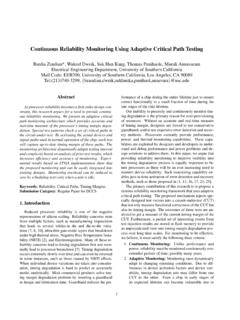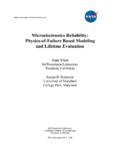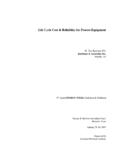Transcription of Reliability Strategy and Plan - University of Tennessee
1 11 Reliability Strategy and Plan2 Reliability Strategy and plan Equipment Asset Management Planned Maintenance: Integration of Maintenance Techniques Continuous Improvement Techniques and Programs Company ExamplesMajor Coverage in Module23 Relationship Between Production, Assets, andMaintenancePrimary Input(Materials, Labor, Energy)Primary Output(End Product)ProductionMaintenanceAsset4 Equipment Asset Management Strategic concept that goes beyond equipment maintenance Includes every stage in the lifecycle of production and manufacturingequipment assets. Design Operation Maintenance Repair35 Equipment Asset Management Reduction in maintenance cost is accomplished by reducing the needfor maintenance. Design for the service Fabricate with proper materials Correct installation Assure lubrication Eliminate chronic problems Enforce proper repair procedures Includes Preventive Maintenance (PM), Predictive Maintenance (PdM)and even Reactive Maintenance (RM) in an optimum combination.
2 Elements such as Total Productive Maintenance (TPM) and ReliabilityCentered Maintenance (RCM) are of Manufacturing and MaintenanceSource:: SQL Systems and ManufacturingMaintenancePre 1945 Assembly LinesReactiveProduction for stockCorrective1945 -1950 Economic expansionReactive1950'sEver increasing demandCorrectiveInvestments in more assets1960'sMore innovationsReactiveIncreased complexity of assetsPreventiveExpanding infrastructure1970'sMarket saturationReactiveParadigm shift from vendor to customerPreventiveCondition monitoringActive/proactive1980'sCustomer is the dominant forceReactiveMRP I/MRP II/JITP reventiveCondition monitoringPredictiveProactive1990'sGloba l competitionReactiveOptimize manufacturing efficiency by MES/PreventiveERP/TQM implementation in the workplacePredictiveNetwork business objectsTPM/RCMP roactiveIntegration with design and
3 EngineeringIntegration with open business systemsIntegration with open control systems47 Maintenance StrategyIntegration of complementary techniques to meet thegoals of optimum equipment Reliability and availabilityfor the least maintenance and operating TO MAINTENANCEPLANNEDREACTIVEMAINTENANCEPRE VENTIVEMAINTENANCEPREDICTIVEMAINTENANCEP ROACTIVEMAINTENANCE59 Operations//Manufacturing Purchasing Maintenance manager Engineering Top management Accounting StoreroomReduce the size and scale of repairsReduce downtimeIncrease accountability for all cash spentReduce number of repairsIncrease equipment s useful lifeIncrease operator, mechanic, and public safetyIncrease consistency and quality of outputReduce overtimeIncrease equipment availabilityReduce number of backup and standby unitsIncrease control over parts and reduce inventory levelImprove information available for equipment specificationLower maintenance costs (better use of labor/materials)Lower overall cost/product unitBENEFITSB enefits of a PlannedMaintenance SystemSource: NASA10 Reactive Maintenance (RM) Also known as breakdown, run to failure maintenance.
4 Maintenance is performed only after the equipment fails. If it ain t broke, don tfix it When it breaks, we ll fix it Little time, effort, or expense is allocated for maintenance until it is absolutelynecessary. When this is the sole type of maintenance practiced:- High percentage of unplanned activities - High replacement part inventories - Inefficient use of maintenance effort A purely reactive maintenance Strategy ignores the many opportunities toinfluence equipment survivability. Typical examples are electronic circuit boards and light bulbs. Justifiable in particular circumstances: - Does not produce critical delays; - Does not sacrifice safety; - Does not significantly increase monitored, scheduled maintenance or inspectionrequired for safety, insurance or regulation?
5 Will the breakdown be more costly than prevention?Is equipment in the critical path for manufacturing?Is backup equipment unavailable ?Will the breakdown adversely affect delivery or customer service?Will the breakdown further damage the equipment?NoNoNoNoNoNoREACTIVE MAINTENANCE JUSTIFIEDPREVENTIVEMAINTENANCED ecision Flow Chart for Preventive Maintenance (PM)12 Preventive Maintenance (PM) Also known as Time-based or Interval-based Maintenance. Maintenance activities are performed on a calendar or operating time intervalbasis to extend the life of the equipment and prevent failure. Performed without regard to equipment condition. Assumes that the condition of the equipment and its need for maintenance iscorrelated with time. This means that most items can be expected to operatereliably for a period X , and then wear FailuresTypical graph of single-piece and simple items such as tires, brake pads,compressor blades, etc.
6 Predictable relationship between age and failure is true in some instances: Equipment that comes in direct contact with product Equipment with visual signs of wear and corrosion14 Patterns of Equipment Failure Graphs show conditional probability offailure against operating age% equipment Type conforming A. Bathtub 4%B. Wearout 2%C. Gradual rise 5%D. Initial increase 7%E. Uniform failure 14%F. Infant Mortality 68%Source: Aladon Maintenance Failure rate (failure/time) is used as a guide to establish taskperiodicities. MTBF = reciprocal of failure rate only in the special case ofexponential life model (constant failure rate case) It provides only the average age at which failure occurs, not the mostlikely age. Can result in unnecessary maintenance.
7 PM can be costly and ineffective when it is the sole type ofmaintenance Maintenance (cont.) Preventative maintenance is only effective in the wear-outphase. If you are in the constant failure phase, and you replace apart you often move back to the infant mortality phase, witha higher failure Maintenance Tasks Are Performed? Checking and cleaning Inspecting Adjustments Lubrication Parts replacement and servicing Calibration Repair of components and equipment18 Examples of PM Car maintenance Change oil per instructions in the manual Undercoating the car with rust-proofing Schedule regular tune-ups Equipment with direct product contact Machine tooling, screw conveyors, furnace refractories, pumpimpellers, Maintenance (PdM) Also known as Condition- Based Maintenance.
8 Uses non-intrusive testing techniques, visual inspection and performancedata to assess machinery condition. Replaces arbitrarily timed maintenance tasks with maintenance that isscheduled when warranted by equipment of Predictive Maintenance Helps reduce cost and improve Reliability : Frequency based preventive maintenance can be delayed if PdMmonitoring shows it is not necessary yet; Equipment with indicators of probable failure prior to scheduled PMactivity are identified and scheduled for maintenance prior to failure; Equipment with conditions that if not repaired will lead to catastrophicfailure are detected and repaired at a fraction of the catastrophic failurerepair of Predictive Maintenance Improves mean-time-to repair due to prediction of failure Reduces inventory levels due to the avoidance of premature parts replacementand the ability to predict parts requirements Improves loading of resources and provides reduced overtime levels due toreduced emergency maintenance Gives the engineer/technician insight into the location and cause of theimpending failure.
9 Reducing diagnosis time if the equipment is permitted to run tofailure22 Methods to Assess Condition of Systems/Equipment Includes intrusive and non-intrusive methods Vibration Analysis Tribology and Lubrication Thermal Imaging and Temperature Measurement Flow Measurement Electrical Testing and Motor Current Analysis Leak Detection Valve Operation Corrosion Monitoring Process Parameters Visual Observations1223 Motor, Turbine GeneratorsTurbinesPumpsElectric MotorsDiesel GeneratorsCondensersHeavy Equipment/CranesCircuit BreakersValvesHeat ExchangersElectrical SystemsTransformersTanks, PipingVibration analysisLubricant, Fuel AnalysisWear Particle AnalysisBearing Temp. AnalysisPerformance MonitoringUltrasonic MonitoringUltrasonic FlowInfrared ThermographyNon-destructive TestingVisual InspectionInsulation ResistanceTECHNOLOGIESAPPLICATIONSS ource: NASA24 Vibration Monitoring and Analysis One of the most commonly used techniques.
10 Helps determine the condition of rotating equipment and structural stabilityin a system. Applicable to all rotating equipment; , motors, pumps, turbines,compressors, engines, bearings, gearboxes, shafts, etc. Conditions monitored: wear, imbalance, misalignment, mechanicallooseness, bearing damage, belt flaws, cavitation, fatigue, Thermography (IRT) Application of infrared detection instruments to identify pictures oftemperature differences It is a non-contact technique Attractive for identifying hot/cold spots in energized electrical equipment,large surface areas such as boilers and building walls, and other areaswhere stand off temperature measurement is and Wear Particle Analysis Is performed for three reasons: To determine the mechanical wear condition To determine the lubricant condition To determine if the lubricant has become contaminated There are a wide variety of tests that will provide information regardingone or more of these areas.
